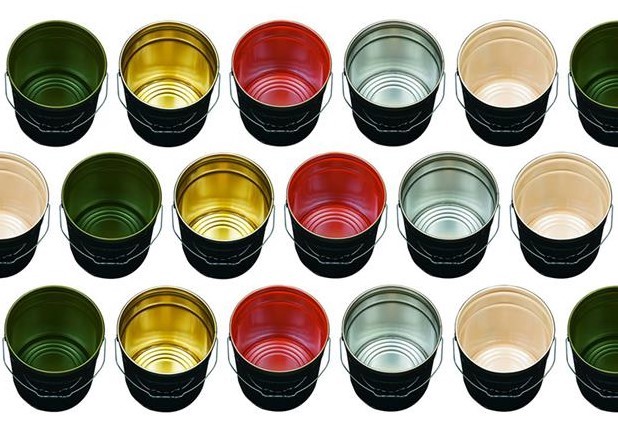Interior coatings play a critical role in protecting steel pails and metal drums from various substances and environmental factors. These linings are applied to steel and tin pails and drums using rollers or a spray and are properly cured with intense heat to shield your containers from potential issues.
While linings are a regular feature for drums and pails, there are some common misconceptions about them. Let’s address some facts and bust some myths about interior pail and drum linings.
Fact: DFT Represents the Level a Lining is Applied to the Steel or Tin Surface
DFT, also known as Dry Film Thickness, is a good indicator of how much the interior of your steel and tin drums and pails are coated with some form of lining. Rust inhibitors are applied in thin coats of around .1 to .2 DFT, while phenolic linings are at a DFT of .6 or more. Your containers’ DFT is regularly checked throughout the fabrication process. These regular checks will help ensure that your drums and pails have an appropriate amount of lining before they’re shipped.
Myth: “Unlined” Steel and Tin Pails and Drums
 While some resellers will list drums and pails as “unlined,” this term can be misleading. Aside from tinplate cans, there are very few metal containers that are sold with their bare metal exposed due to rusting concerns. Instead, most metal drums and pails at least include a rust inhibitor, which is also known in the industry as “size” or a “size coating.”
While some resellers will list drums and pails as “unlined,” this term can be misleading. Aside from tinplate cans, there are very few metal containers that are sold with their bare metal exposed due to rusting concerns. Instead, most metal drums and pails at least include a rust inhibitor, which is also known in the industry as “size” or a “size coating.”
The purpose of a rust inhibitor is to slow the process of oxidation. While this type of lining does not prevent rust entirely, coating drums and pails with a rust inhibitor will make a major difference in comparison to true unlined container. It’s important to note that even with a rust inhibitor, you should store drums and pails in relatively low humidity and regularly rotate stock if possible.
An additional benefit of rust inhibitors is that it serves as a good primer for other linings. These coatings have good adhesive qualities, which can make it easier for other types of linings to cling to your drums and pails.
Fact: Linings Are Required for Certain Chemicals
While protecting your drums and pails with linings is generally a good idea, there are situations where coatings are mandatory. Certain chemicals and other products can require linings for transport. Government agencies like the Department of Transportation have specific rules for transporting hazardous materials listed in Title 49 of the Code of Federal Regulations, which includes container linings for certain chemicals. In addition, FedEx and UPS have their own shipping requirements for certain materials. As such, linings may be more than just a good idea – they can be a necessity.
Myth: Uncolored Phenolic Lining for Drums and Pails
Choosing coating colors is similar to picking out paints for your house – You select the pigment you like and someone mixes that pigment to a base white coat of paint. However, there is no truly clear base color for phenolic linings. While phenolic lings are clear when applied, they naturally turn to a see-through gold when exposed to heat in the curing process. Opaque green and red phenolic linings are also available with the addition of pigment.
Fact: You Need to Pick and Choose Lining Types to Match Your Product
There is no single coating solution for every product. Fill products have different pH ranges and other qualities that can call for specific types of drum and pail lings. For example, phenolic linings can typically hold products with a pH range of 3.0 to 7.0. Meanwhile, adding an epoxy resin will increase the flexible properties of the lining and reduce its resilience to acids, giving epoxy phenolics a pH range of 7.0 to 9.0. Each product will require individual testing, but the certain types of linings are typically used for the following products:
- Epoxy Phenolics
- Latex products
- Detergents
- Water-based products (inks, etc.)
- Phenolics
- Alcohol
- Solvent-based resins
- Refrigerants
- Lacquers
- Vegetable oils
Myth: You Don’t Need a Chemistry Degree to Select the Right Lining
Fortunately, you don’t need extensive knowledge of your fill products chemical properties to narrow down the right linings for steel and tin drums and pails. Your selection process boils down to a couple factors – your safety data sheet (SDS) and your packaging distributor.
The SDS describes the chemical properties of your fill product, which will allow experts to determine what is required to safely contain it. From there, your distributor can turn to specialists – or even the lining manufacturer itself – to evaluate a proper lining during the early stages of packaging development.
Fact: You Should Test Your Pail and Drum Linings
While an SDS and lining specialists can definitely help you find the right linings for your drums and pails, it’s critical to test your packaging. The SDS will have chemical properties and possible active ingredients listed, but it won’t specifically say what is compatible with your fill product. That’s a major problem if you invest in packaging only to find out your lining isn’t right for your fill product.
At Pipeline, our packaging engineers help you evaluate which lining is right for the metal drums and pails. Ready to invest in the perfect packaging for your products? Check out our available packaging products online and our team can work with you to determine the perfect packaging and linings for your fill products.


